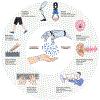Artificial Intelligence-Powered Electronic Skin
- PMID: 38370145
- PMCID: PMC10868719
- DOI: 10.1038/s42256-023-00760-z
Artificial Intelligence-Powered Electronic Skin
Abstract
Skin-interfaced electronics is gradually changing medical practices by enabling continuous and noninvasive tracking of physiological and biochemical information. With the rise of big data and digital medicine, next-generation electronic skin (e-skin) will be able to use artificial intelligence (AI) to optimize its design as well as uncover user-personalized health profiles. Recent multimodal e-skin platforms have already employed machine learning (ML) algorithms for autonomous data analytics. Unfortunately, there is a lack of appropriate AI protocols and guidelines for e-skin devices, resulting in overly complex models and non-reproducible conclusions for simple applications. This review aims to present AI technologies in e-skin hardware and assess their potential for new inspired integrated platform solutions. We outline recent breakthroughs in AI strategies and their applications in engineering e-skins as well as understanding health information collected by e-skins, highlighting the transformative deployment of AI in robotics, prosthetics, virtual reality, and personalized healthcare. We also discuss the challenges and prospects of AI-powered e-skins as well as predictions for the future trajectory of smart e-skins.
Keywords: artificial intelligence; electronic skin; human-machine interfaces; machine learning; personalized healthcare.
Conflict of interest statement
Competing interests: Authors declare no competing interests.
Figures





References
Grants and funding
LinkOut - more resources
Full Text Sources
